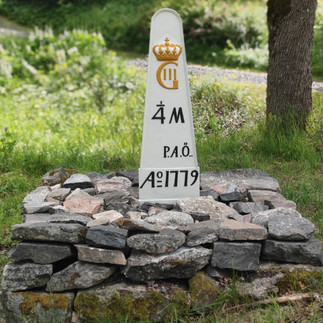Adventures on Sormlands 100 Route (section 3, unofficial)
- Chris Toepker

- Aug 6, 2023
- 3 min read
Here’s hoping you’ll join us, out there, just forestbathing…at speed.

This time? We’re out along the Sormlands100 route, across the (unofficial) third section, stretching from Gnesta to Tystberga. Each section I’ve done is a marathon distance, and here we wander along the Eriksgatan trail, touch the Sörmlandsleden and pass Iron Age sites such as fornborgs, graveyards and charcoal making sites, plus several historical manor farms.
As for the run, I have to say that it’s among the easier. So far, the first and third sections are roughly the same style. Plenty of ups and downs through rolling farmlands and working forests, but many country and logging roads. This contrasts with the very difficult and technical twists and turns across rocky (easy to lose!) ways of section one.
As always, many thanks to Billy White for organizing the Sormlands100. As he writes, "It is important to us that Sörmlands 100 isn’t just a race, we really want to highlight the stunning landscape of the region and also the amazing food producers and restaurants." Couldn't agree more - it's amazing.
Getting onto this section of the route is easy from Stockholm, just take one of the many inter-city trains to Gnesta. Then head out on the main road to the trailhead here. There’s no ready parking, so driving is actually more difficult.

Almost immediately, you’ll come across an iron age graveyard, mostly marked by a large circle of stones. The fences are to keep in the farm animals, mostly horses in this section. I haven’t tested the “right to roam” there, but you’re supposed to be able to cross the fence and wander around as long as you don’t cause trouble or damage.
Along the way, the age of the roads and byways is evident from the mile markers, each “mil” being 10 kilometers. The oldest one I’ve seen so far is from 1779, and it’s along this section. Interestingly, the king would build the initial road and then local farmers and gentry were responsible for upkeep. That’s a long time to keep the thing up, for sure!
About 10 kilometers in and you’ll come across Jakobsberg farm, basically a fief (although more technically an “entrusted estate”) perhaps most famously of the Wattrang nobility. First established in 1562 as a freehold (or “salvation” or “frelsegårds”) estate by the baronial Bielkenstierna family, who ultimately sold it to the Wattrangs in 1674. They then owned it until 2004, when Helga “Lottie” Tham (daughter of the founder of H&M, Erling Persson) took ownership. To underscore the throughline of history though, there are even more ancient burial grounds on the estate, mostly round stone burials.
Across more forests and farms, through a few villages, at about 25 kilometers we reach Öster-Malma manor, taking it’s name for being on the west side of Malmasjön lake. This castle was built in 1668 for Böös Drakenhielm, a royal chamberlain and Chief Customs Officer. In 2003 the site was refurbished and is now a hotel, restaurant and conference center. It also has a wildlife preserve and park. So, perhaps not surprising that it’s owned by the Swedish Hunters’ Association.
From here on, the route passes through a few working forests, and then opens up into wide farm fields. As my friend and colleague Goran noted on our first recce of the route: “We’re hiking straight into the Windows 98 screen saver.” He ain’t wrong!
Ultimately, you’ll have to veer off the Sormlands 100 route here, to go into Tystberga. From here you can catch a bus to Nyköping and get a bus or train back to Stockholm.
Don’t have all morning to run? Or all day to hike? We got you covered! Here’s a timewarp of the route you can study. As always: we’ll see you out there, #BreakingImpossible!







































Comments